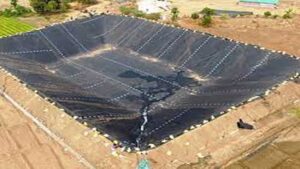HDPE Geomembranes in Agriculture: Enhancing Water Conservation
4 min readIn the face of global water scarcity and the increasing need for sustainable agricultural practices, High-Density Polyethylene (HDPE) geomembranes have emerged as a game-changing solution. These versatile materials are revolutionizing water conservation efforts in agriculture, particularly in arid regions like the United Arab Emirates (UAE). This blog post explores how HDPE geomembranes are enhancing water conservation in agriculture, with a special focus on applications in the HDPE Geomembrane UAE market.
The Water Challenge in Agriculture
Agriculture is the largest consumer of freshwater globally, accounting for about 70% of all freshwater withdrawals. In water-scarce regions like the UAE, this presents a significant challenge. The need to produce more food with less water has never been more critical, driving the adoption of innovative technologies and practices.
Enter HDPE Geomembranes
HDPE geomembranes offer a robust solution to many water conservation challenges in agriculture. Their unique properties make them ideal for various applications:
- Impermeability: HDPE geomembranes provide an excellent barrier against water seepage.
- Durability: They can withstand harsh environmental conditions, including UV radiation and extreme temperatures.
- Chemical Resistance: HDPE is resistant to many agricultural chemicals, ensuring long-term performance.
- Flexibility: These geomembranes can conform to various shapes and terrains.
Let’s explore how HDPE geomembranes are being used to enhance water conservation in agriculture:
- Lining Irrigation Ponds and Reservoirs
One of the primary applications of HDPE geomembranes in agriculture is lining irrigation ponds and reservoirs. This practice has seen significant adoption in the HDPE Geomembrane UAE market.
Benefits:
- Prevents water loss through seepage
- Reduces evaporation when combined with floating covers
- Improves water quality by preventing soil contamination
Case Study: In the emirate of Abu Dhabi, a large-scale date palm plantation implemented HDPE-lined reservoirs, reducing water loss by over 40% and significantly improving irrigation efficiency.
- Canal Lining
Agricultural canals are often sources of significant water loss due to seepage. HDPE geomembranes provide an effective solution for canal lining.
Benefits:
- Minimizes water loss during transportation
- Reduces maintenance costs compared to concrete linings
- Allows for faster water delivery, reducing evaporation losses
UAE Application: The Al Ain region has implemented HDPE geomembrane-lined canals in its oasis agriculture system, significantly improving water delivery efficiency to date palm and fruit orchards.
- Greenhouse Floor Lining
In protected agriculture, HDPE geomembranes are used to line greenhouse floors, contributing to water conservation and crop health.
Benefits:
- Prevents water and nutrient loss to the subsoil
- Facilitates collection and recycling of excess irrigation water
- Helps maintain a sterile growing environment
UAE Innovation: Hydroponic farms in Dubai are utilizing HDPE geomembranes as part of their water-efficient growing systems, enabling year-round vegetable production with minimal water use.
- Aquaculture Pond Lining
HDPE geomembranes are increasingly used in aquaculture, an emerging sector in the UAE’s food security strategy.
Benefits:
- Prevents water loss and groundwater contamination
- Enables precise control of water quality parameters
- Facilitates easier pond cleaning and maintenance
UAE Development: Coastal aquaculture projects in Umm Al Quwain are utilizing HDPE geomembranes to create efficient, water-conserving fish farming systems.
- Runoff Collection Systems
In areas prone to occasional heavy rainfall, HDPE geomembranes are used to create runoff collection systems, capturing valuable water for agricultural use.
Benefits:
- Harvests rainwater that would otherwise be lost
- Reduces reliance on groundwater or desalinated water
- Helps prevent soil erosion
UAE Application: Farms in the mountainous regions of Ras Al Khaimah have implemented HDPE-lined catchment areas to capture and store rainwater for dry season use.
- Subsurface Irrigation Systems
Innovative subsurface irrigation systems using HDPE geomembranes are emerging as a highly efficient watering method.
Benefits:
- Minimizes evaporation losses
- Delivers water directly to plant roots
- Reduces weed growth and related water competition
UAE Research: Agricultural research centers in the UAE are experimenting with HDPE geomembrane-based subsurface irrigation systems for water-efficient cultivation of native plants and crops.
Challenges and Considerations
While HDPE geomembranes offer numerous benefits for water conservation in agriculture, there are some challenges to consider:
- Initial Cost: The upfront investment for HDPE geomembrane installation can be significant, although long-term water savings often justify the cost.
- Installation Expertise: Proper installation is crucial for optimal performance, requiring skilled professionals familiar with local conditions.
- Maintenance: Regular inspection and maintenance are necessary to ensure long-term effectiveness.
- End-of-Life Management: Proper disposal or recycling of HDPE geomembranes at the end of their lifespan must be considered.
The Future of HDPE Geomembranes in Agricultural Water Conservation
The role of HDPE geomembranes in agricultural water conservation is set to grow, driven by several factors:
- Technological Advancements: Ongoing research is improving the performance and lifespan of HDPE geomembranes.
- Climate Change Adaptation: As water scarcity increases due to climate change, the demand for efficient water conservation solutions will rise.
- Food Security Initiatives: Countries like the UAE are investing heavily in agricultural self-sufficiency, driving the adoption of water-efficient technologies.
- Sustainability Goals: The use of HDPE geomembranes aligns with broader sustainability objectives in agriculture.
- Smart Agriculture: Integration of HDPE geomembranes with smart irrigation systems and IoT sensors is enhancing water use efficiency.
Conclusion
HDPE geomembranes are playing a crucial role in enhancing water conservation in agriculture, particularly in water-scarce regions like the UAE. From lining irrigation ponds to enabling efficient greenhouse production, these versatile materials are helping farmers produce more food with less water.
The HDPE Geomembrane UAE market is at the forefront of this agricultural innovation, driven by the nation’s commitment to food security and sustainable development. As water becomes an increasingly precious resource, the importance of HDPE geomembranes in agriculture is only set to grow.
By embracing these technologies and continually innovating in their application, we can work towards a future where agricultural water use is optimized, helping to ensure food security while preserving our most vital resource. The success of HDPE geomembranes in UAE agriculture serves as a model for other arid regions, demonstrating how innovative materials can contribute to sustainable farming practices in challenging environments.



